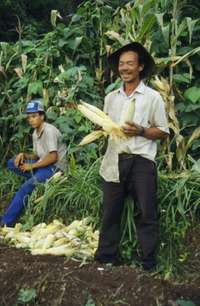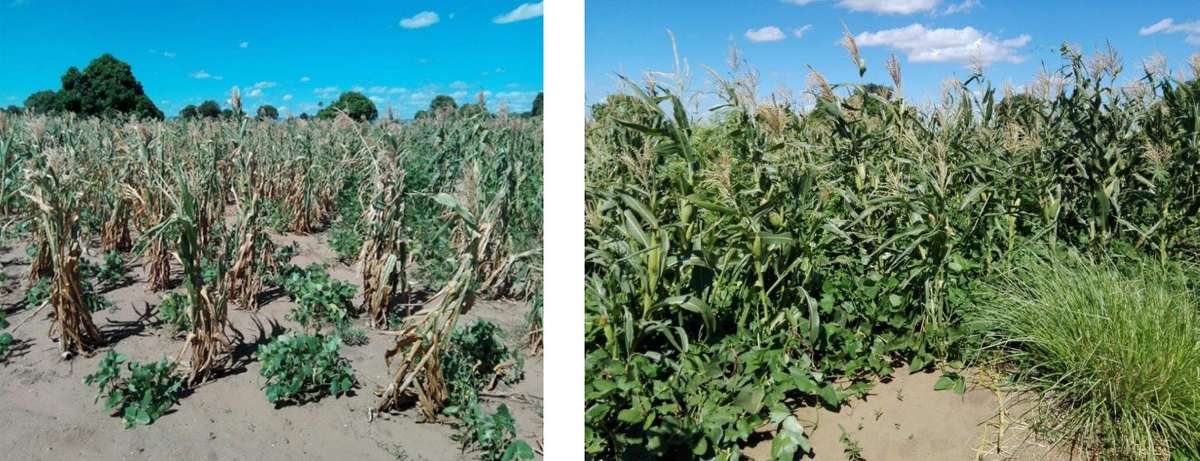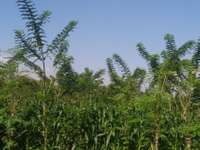Antonio Guterrez, the Secretary General of the United Nations, has described the rapidly worsening famine around the developing world as the “Hurricane of Hunger.” Many experts say that as many as 60 million Africans, mostly small children, are in danger of dying from it in the next two decades, and the rapidly growing disaster has no end in sight. If even just these 60 million people were to die, this tragedy would stand as the worst famine in human history.

Honduras. This farmer used to harvest one small ear (like the one in his left hand) from each stalk, but now produces two larger ears (like the two ears in his right hand) from each stalk, mostly because of the legume climbing up the maize in the background. The soil at his feet is now black and porous. More importantly, his son is still living in the village, instead of being forced to flee to the city slums because the farm’s previously diminishing productivity would not have supported his future family for another generation. (Compare this soil’s color, texture, and water-holding capacity with that in or near the other fields below.)
To cure a disease, we must diagnose it accurately. But 20 years into the droughts, the world’s leaders have failed to do so. Before 2010, famines in Africa rarely affected more than 10 million people. By 2017, the United Nations’ Food and Agriculture Organization (FAO) declared that 20 million people in Africa and Yemen were in serious need of food aid. By 2020, that number had risen to 40 million in Africa alone, and today it stands at over 60 million. Obviously, given this timeline, the Hurricane of Hunger has not been caused by the war in Ukraine or the sanctions put in place to end that war, as many people think.
These people in need of food aid have largely been fed by the World Food Program, so few people elsewhere realized what was happening. While food aid can prevent people from dying at the time, it is not a solution to the problem of hunger. Rather, it is only a short-term, rather expensive band-aid that masks the problem so that far too few people around the world realize the extent of the disaster. By allowing the wound to fester it has allowed the disaster to spread and endanger the lives of tens of millions of additional people, while at the same time it has almost depleted the WFP’s stores of food.
The fact that the Hurricane of Hunger has been growing worse and worse for more than two decades is, in fact, consistent with what most people believe to be causing these crippling droughts: climate change. But we have convincing evidence that climate change is only about 20% of the problem. First of all, the actual rainfall across Africa has not decreased hardly anywhere by more than about 5 to 10%. Such a small decrease could not be causing the devastating droughts that are now occurring every second or third year across most of sub-Saharan Africa.
So what is causing the problem? Almost any smallholder farmer in drought-prone Africa will provide evidence of the real nature of the problem. Just ask this simple question of any smallholder farmer who has a typically heavy clay soil: “how deep does your soil get wet after a 4- to 5-hour tropical downpour?” He or she will tell you, as a couple hundred of them have told me, that it only gets moist down to about 15 cm, at most. The soil any deeper than that remains bone dry. On the other hand, in areas where the soil is dominantly sandy with little organic matter, almost all the water will continue draining deeper and deeper, down to below where nothing but tree roots can reach it.
So why is this becoming such a problem right now? For over 2,000 years, African farmers kept their soils fertile by forest fallowing (also called “slash-and-burn agriculture” or “shifting agriculture”). This system kept the soil fertile for millennia with no use of synthetic fertilizers, despite the people’s consuming significant amounts of nutrients taken from the soil three to five out of each 15 to 25 years. Forests have also kept the weeds under control, largely controlled insects and plant diseases (without pesticides), sustained trillions of microorganisms/ha that helped feed plants, produced tremendous amounts of biomass, sequestered many tons/ha/year of carbon in the soil, and totally prevented droughts, for literally millions of years. And the forests themselves required absolutely no human labor to do all this.
What, then, is the problem now? Because of human population growth, the amount of land available for Africa’s rural households had, by the 1980s, decreased to less than 1.5 ha/family. With so little land, farmers could not grow forests on their land for 15 years at a time and still have enough land left to produce the basic grains their families needed. Farmers were forced to gradually reduce their fallowing time from 15 to 20 years in the 1980s down to almost nothing. Forest fallowing is now on its deathbed across sub-Saharan Africa. As a result, the organic matter content of the soil has dropped from about 4% before the 1980s to less than 1% today. This, in turn, according to scientific experiments in Malawi, has caused the rainwater infiltration rate to drop from 60% to 10 or 20%, because with so little organic matter, the dominant clay soils become almost rock-hard. In other words, whereas climate change has caused rainfall to be reduced by at most 10%, soil degradation has reduced the amount of water that can infiltrate into the soil by 65 to 80%! This loss of soil organic matter is therefore far and away the greatest cause of these crippling “droughts.”
So what can we do about it? First of all, the fact that soil degradation, rather than climate change, is the primary cause of the increasing hunger, means that the farmers no longer need to be helpless victims of climate change. They themselves will have the power to solve the problem if they are just taught a few extremely inexpensive farming practices.
How? Similar “droughts” and loss of soil fertility have been occurring in many parts of Latin America since about the 1960s. As a result, one small group of agronomists from two organizations in Brazil (EPAGRI and ASOIAPAR) and a second small group from World Neighbors and Oxfam/UK in Central America, began trying a series of different technologies, including composting and using animal manure, but these proved to be either excessively expensive or prohibitively time-consuming.
Finally, in about 1978, each group independently discovered a technology that does the trick: green manure/cover crops (gm/ccs). These plants, including leguminous trees, bushes, climbers, and creepers, can fertilize the soil and overcome droughts very cheaply, while at the same time, significantly reducing over-all labor costs, especially for women! Today, in Brazil and Paraguay, over 25 million hectares of land have become free of droughts and highly productive because of gm/ccs. And in Africa alone, there are now thousands of farmers in each of six African nations—Mali, Cameroon, Zambia, Malawi, Mozambique and Madagascar—who have been using introduced gm/ccs for at least six years. Most of these farmers’ maize yields in years of good rainfall have increased from less than 1 ton before using gm/ccs to at least 3 tons/ha/year. But even more important, their yields in droughty years have increased from almost nothing to about 2.5 tons/ha! That is, the droughts now reduce farmers’ much-improved harvests by less than 20%. Lack of rainfall is obviously not the major cause of the “droughts.”
Furthermore, we have gradually found that, around the world, there are a total of over 15 million smallholder farmers who have already discovered the benefits of gm/ccs by themselves. Most of these farmer innovators (like the woman from Madagascar pictured on the next page) have been using gm/ccs now anywhere from 6 to over 500 years.
During this process, these farmers have discovered, just like those of us from Brazil and Central America, that gm/ccs can solve more than just the droughts. Sure, gm/ccs can make the soil soft and porous and able to absorb and hold plenty of rainwater. But they can also provide the shade and a mulch cover that will allow the moisture to stay there longer. They keep the soil fertile by fixing nitrogen and recycling other nutrients more efficiently, they make plowing and soil preparation totally unnecessary, they control weeds, they reduce the incidence of pests and plant diseases, they sequester tons of carbon/ha in the soil every year, they dramatically increase crop productivity, and they can do all this for centuries, with absolutely no need for synthetic fertilizer or any other recurring monetary expense. At the same time, they can dramatically reduce both farmers’ cash costs and labor demands. And African women benefit more than anyone else. These gm/ccs end all need for soil preparation, many of them end at least half of women’s weeding work, and they can also provide up to 10% of all the firewood a family needs without walking six kilometers to the forest and back.

Madagascar. The only difference between this woman’s two fields is that this is the first year the field on the left has had a 9-month cowpea growing in it, whereas the field on the right has had the cowpeas there for six years, giving it almost total resistance to the droughts. The second field produced more than six times the maize harvest/ha that the first field did. These two fields obviously weathered the same drought because they exist right next to each other, as is evidenced by the fact that the same two clouds on the right side of the first photo had only moved to about half-way across the fields by the time the second photo was taken. The addition of trees in these fields would, of course, increase soil moisture retention further by providing shade and reducing wind speeds.
Does all this sound virtually impossible? Frankly, yes. But these are precisely the same advantages that we listed above in the case of natural forests. For these reasons, the most important motto of the gm/cc movement is to “imitate the forest,” which is a very simple process. And where these practices are being taught and used correctly, these gm/ccs are spreading spontaneously across the landscape faster than any other technology I have worked with over the last 50 years.
Of course, a lot of scientists from the temperate countries have been taught that intercropping does not work. That is true—but only in the temperate climates. There is a huge, little understood difference between these two environments. First of all, the very demarcation of the tropics is such that the tropics include all the areas where, at least once each year, the sun is almost directly overhead. This means that in the temperate areas of the world, a short plant of beans in among a crop like maize or millet will only receive the sunlight that comes in at an angle, heavily blocked by three or four rows of maize or millet, rather than receiving the sunlight from directly above, in which case it receives all the sunlight that can come through a half-dozen narrow leaves. The difference in the amount of sunlight received is significant. But there is another factor people are even less aware of. During the months of June to September, the sun is almost directly overhead in the northern tropics, between the equator and the Tropic of Cancer, and the rainy season, or growing season, occurs during precisely these same months. In the southern tropics, from the equator south to the Tropic of Capricorn, the sun is directly overhead during the months from November through February, and these are precisely the months when people can plant their crops in this area. So in both cases the sun is almost directly overhead precisely when farmers are growing their crops.

Mali, West Africa. Since there is a row of millet right where these “dispersed shade” trees are planted, the trees are not reducing the plant population of the main crop, one of the major problems that has hindered the adoption of alley cropping. These women have pruned their gliricidia trees at the right height, while standing on the ground. Still, the trees are not as heavily pruned as we would normally recommend, because these women are selling gliricidia seeds for about US $ 5.00/kg to other farmers, thereby increasing their income while spontaneously spreading the technology to other farmers who have observed its results and wish to adopt the system.
What kind of plants are capable of working all these miracles? There are well over one hundred species of gm/ccs in use today across the world. But over the last five years, working in some 20 nations of Africa, I have found that there are just two gm/cc systems that are the most popular across Africa, and are well-suited to at least 80% of drought-prone, lowland sub-Saharan Africa. Using these systems and then creating a forest with them, the droughts could be brought to an end.
One system consists of using jackbeans, gliricidia trees (also called “mother of cacao”), and lablab beans, intercropped in people’s maize fields. The second one involves jack beans, gliricidia trees, and pigeon peas, with any number of different food or cash species growing under the pigeon peas, such as cowpeas, groundnuts, soybeans, or pumpkins, all intercropped in either maize, sorghum, millet or cassava fields. In each case, these gm/ccs provide a tremendous amount of high-protein food, in addition to the sustainably tripled basic grain yields. For instance, the first of these systems provides edible gliricidia flower petals, plus the edible leaves, pods, green peas, and dry beans of the lablab bean, a native African plant whose beans contain about 50% more protein than do our Western beans. The lablab plant alone produces huge quantities (up to 30 t/ha) of fresh leaves during 11 months out of the year, which can provide plentiful amounts of vitamins and minerals, along with a content of about 12% protein. They thereby constitute a plentiful source of vitamins, minerals and proteins that are virtually free (being a by-product of producing the marketable lablab beans) and available year-round—a veritable nutritionists’ dream come true.

Malawi. This farmer has successfully “imitated the forest” right in his maize field. The maize is growing beautifully, even back in the middle of the field, in spite of (or rather, because of) the dense population of other food crops and forest plants, and in spite of a drought. Each farmer’s field will end up with different plants, depending on the farmers’ food preferences, the species available in the forest, and local climatic conditions, but the increased yields, resistance to drought, and additional half-dozen benefits provided by this field, will be fairly similar. The plant population is greater in this field than in any temperate-climate field because the roots can find plentiful nutrients both deep in the soil and up in the mulch, so they grow less horizontally.
Furthermore, interest in gm/ccs among development organizations has increased significantly over this last two years, in part because the damage being done by the “droughts” is still rapidly increasing. As a result of this and the effectiveness of the technology, we now know how to end the Hurricane of Hunger in Africa very cheaply, and know it can be accomplished within one generation.
I have therefore written four papers totaling just 27 pages: this one on the general situation, and three more on specific species. Spread widely enough and put into practice, I believe these papers could do most of what is needed to end the Hurricane of Hunger. Please feel free to use these papers, translate them into local languages, send them to friends and co-workers, ask me about any questions you may have about them, and ask me for copies of the papers on specific species you will be using that you have not already received. My email address is rbunchw@proton.me. I may not be able to answer immediately, but will do my best to answer as soon as possible. If you work in other areas, such as the African highlands or in Latin America or Asia, you may want to obtain my book, Restoring the Soil, How to Use Green Manure/Cover Crops to Fertilize the Soil and Overcome Droughts, available from ECHO/Florida.
(About the photos: The first and fifth photos in this paper are of gm/cc systems we were working with, but were still in progress. They have not had the time to add more biodiversity, but are therefore better for illustrating certain issues. The second and third photos are of asystem developed entirely by smallholder farmers themselves. The fourth is a photo of a well-developed, biodiverse system developed by a farmer we were advising. Because the pruning of the trees is done just before the growing season, the tree cover here will be much greater during the dry season, when there is obviously an equally great need to maintain soil moisture levels. After all, most gm/ccs must grow through the dry season so their green leaves can be applied right before the following crop most needs the nutrients.
The only synthetic fertilizer used in any of the fields in these photos was a very few pounds used in equal amounts in each of the two plots in Madagascar.)